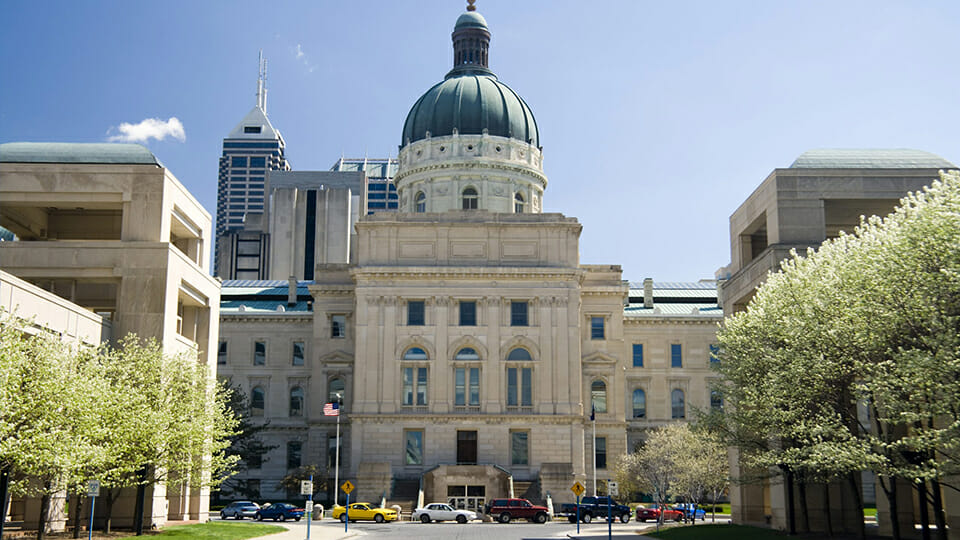Indiana abortions jumped in 2022 but have dropped this year, reports say
Subscriber Benefit
As a subscriber you can listen to articles at work, in the car, or while you work out. Subscribe Now
Last year, as Indiana’s neighbors limited abortion, Hoosier providers performed hundreds more procedures than is typical, state reports released Friday shows. But after the state passed its own near-total ban — despite a statewide preliminary inunction — procedures dropped.
Also on Friday, Indiana’s Supreme Court ruled in favor of the ban, clearing the way for it to go into effect by August. An injunction issued in a separate religious freedom challenge only applies to the plaintiffs in that case.
“In-state abortion numbers show a slight decline in both medication and surgical abortion care. We don’t have enough information to know why exactly,” Planned Parenthood’s Indiana spokeswoman Nicole Erwin said of the drop. But she suggested that Indiana’s status as the first state in the nation to call a special session and pass a ban could have led Hoosiers to prepare via contraceptives or sterilization.

“Today’s decision is not the end of our fight for equitable, compassionate care in Indiana, or the patients in surrounding states who rely on us for access to abortion,” Erwin added in a written statement. “We will continue to show up for the people of Indiana, however we can in support of the care they need.”
Right to Life of Indiana President and CEO Mike Fichter said “In the brief time SEA 1 was in effect, abortions plunged. But when the lower court blocked it, Indiana became an abortion destination state. This is exactly what we warned would happen. We are hopeful the recent Indiana Supreme Court ruling ends this exploitation by abortion businesses in the Hoosier state.”
Dubious abortion haven
Abortions have waxed and waned in Indiana as legal complexities have increased, but the proportion of out-of-staters obtaining procedures in the Hoosier state continues to be significant.
Indiana’s providers performed more than 9,500 abortions in 2022, a 13% increase from the year before, according to the Indiana Department of Health’s (IDOH) latest annual terminated pregnancy report. Abortion filings surged in July, just after the U.S. Supreme Court returned abortion policy to the states.
Since then, the number of procedures performed has fallen — despite a preliminary injunction that blocked the ban after just one week of effectiveness, in September 2022. At least one provider has closed and others have had staffing troubles as they awaited word about their future.
In its first-ever quarterly edition of the report, IDOH recorded a 15% drop in abortions from January through March of this year compared to that time period in 2022, down from about 2,300 to 1,900.
But more non-residents are among those patients.
“In-state abortion numbers show a slight decline in both medication and surgical abortion care. We don’t have enough information to know why exactly,” Planned Parenthood’s Indiana spokeswoman Nicole Erwin said of the drop. But she suggested that Indiana’s status as the first state in the nation to call a special session and pass a ban could have led Hoosiers to prepare via contraceptives or sterilization.
The majority of non-residents are from Kentucky, which has its own near-total ban in effect. They made up more than half of out-of-staters in 2022 and were nearly 90% of that subtotal in the first quarter of 2023, according to the IDOH reports.
Hundreds of Ohio residents sought abortions in Indiana last year, but just eight have ventured to the state so far this year. IDOH also recorded patients from Tennessee, Michigan, Illinois and beyond.
“Right now, 20 states have banned or eliminated all or some access to abortion,” Planned Parenthood’s Erwin said. She said the number of non-residents seeking medication abortions through the organization has more than doubled, while those pursuing surgical options grew two-and-a-half times.
Providers, weeks in and more
Planned Parenthood performed nearly half of the state’s abortions in 2022, but dropped to about 41% in the first months of 2023; one of the organization’s four abortion-performing locations was not performing procedures during that time.
The Women’s Med Center of Indianapolis performed the next most — at 31% of the total last year and 36% so far this year — followed by the Clinic for Women at 14% and 20%. Whole Women’s Health of South Bend, which performed single-digit percentages during both time periods, has since closed.
A smattering of Indiana hospitals that perform abortions logged relatively few, with each at or below 1% of the total. That’s consistent with previous years.
And with many providers located in the Indianapolis area — the state’s capital and most populous city — Marion County once again led the state’s abortion count: 73% of the total in 2022 and 59% so far this year.
In both reports, the vast majority of patients terminated their pregnancies between six and nine weeks. Medical abortions were slightly more common than surgical ones in 2022, and are becoming more prevalent so far this year.
Fewer white people have sought abortions thus far in 2023, dropping from 48% of the total in 2022 to 42% in the first quarter of this year. The proportion of Black people, as well as those of “other” and “unknown” races, has increased the most.
The share of those who are unmarried has stayed relatively constant, at 86%.
The Indiana Capital Chronicle is an independent, not-for-profit news organization that covers state government, policy and elections.
